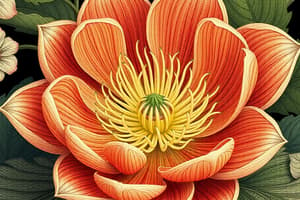Podcast
Questions and Answers
Which part of the flower is responsible for protecting the reproductive organs and providing a surface for pollen grains to adhere?
Which part of the flower is responsible for protecting the reproductive organs and providing a surface for pollen grains to adhere?
- Corolla (correct)
- Androecium
- Calyx
- Stamen
What does the gynoecium consist of in a flower?
What does the gynoecium consist of in a flower?
- Sepals and petals
- Anther, filament, and pollen grains
- Pollen grains
- Ovary, style, and stigma (correct)
Which part of the flower encloses the rest of the flower in the bud stage?
Which part of the flower encloses the rest of the flower in the bud stage?
- Calyx (correct)
- Pistil
- Androecium
- Corolla
What is the male reproductive part of the flower made up of stamens known as?
What is the male reproductive part of the flower made up of stamens known as?
What is the structure that produces pollen grains, which are the male gametes?
What is the structure that produces pollen grains, which are the male gametes?
Which flower part is responsible for the formation of the embryo sac?
Which flower part is responsible for the formation of the embryo sac?
What happens to the ovules after fertilization in a flower?
What happens to the ovules after fertilization in a flower?
Which part of the flower develops into the fruit?
Which part of the flower develops into the fruit?
In the process of pollination, where are the pollen grains typically transferred to?
In the process of pollination, where are the pollen grains typically transferred to?
Which whorl of the flower consists of fragrant, colored, thin, and soft parts that attract animals and insects for pollination?
Which whorl of the flower consists of fragrant, colored, thin, and soft parts that attract animals and insects for pollination?
Flashcards are hidden until you start studying
Study Notes
Sexual Reproduction in Flowering Plants: An In-depth Look at Flower Structure
Sexual reproduction in flowering plants, also known as angiosperms, is a complex and fascinating process that involves the coordination of different parts of the flower to ensure the production of viable seeds. This process starts with the structure of the flower, which is comprised of several key parts that play a crucial role in reproduction.
Calyx
The calyx is the outermost whorl of the flower and is made up of units called sepals. In the bud stage, the calyx encloses the rest of the flower. The calyx can either be prominent or absent and may exhibit green coloration or be petaloid, meaning it resembles the petals in color and texture.
Corolla
The corolla is the second whorl of the flower and is made up of many petals. These petals are often fragrant, colored, thin, and soft, which helps in the process of pollination as they attract animals and insects. The corolla plays a crucial role in the process of reproduction as it protects the reproductive organs and provides a surface for pollen grains to adhere.
Androecium
The androecium is the male reproductive part of the flower and is made up of stamens. Each stamen consists of a filament and an anther. The anther contains pollen grains, which are the male gametes. The anther is the part of the stamen that produces pollen. The androecium is responsible for the development of the pollen tube, base germination of pollen, and the formation of gametes.
Gynoecium
The gynoecium is the female reproductive part of the flower and is made up of carpels. Each carpel consists of an ovary, a style, and a stigma. The ovary is the part of the carpel that contains the ovules, which are the female gametes. The ovules are converted into seeds after fertilization. The gynoecium is responsible for the formation of the embryo sac, which is the female gametophyte. The ovary is also the part of the flower that develops into the fruit, which contains the seeds.
Pollination
Pollination is the process by which pollen grains are transferred from the anther of the male flower to the stigma of the female flower. This process enables fertilization, resulting in the production of seeds. Pollination can occur through various means, including wind, water, or animals, such as insects and birds.
Fertilization
Fertilization occurs when the pollen tube grows through the stigma and style of the female flower and reaches the ovule. The male gametes (sperm) from the pollen tube then fuse with the female gametes (egg) in the ovule, resulting in the formation of a zygote. The zygote then begins to divide and develops into an embryo, which eventually becomes a seed.
Functions
The parts of the flower have specific functions in the process of sexual reproduction. The calyx and corolla provide protection and attract pollinators, respectively. The androecium produces and releases pollen, while the gynoecium receives the pollen and produces the seeds.
In conclusion, the structure of the flower plays a crucial role in the process of sexual reproduction in flowering plants. The coordinated development of the different parts of the flower, from the calyx to the gynoecium, ensures the successful production of seeds and the continuation of the plant species. Understanding these processes is essential for the conservation of plant species and the development of sustainable agricultural practices.
Studying That Suits You
Use AI to generate personalized quizzes and flashcards to suit your learning preferences.




